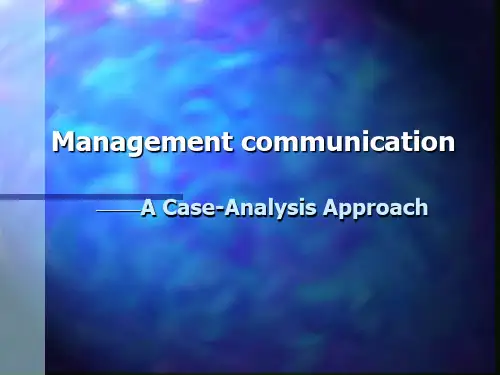管理沟通(英文)8
- 格式:ppt
- 大小:554.50 KB
- 文档页数:88

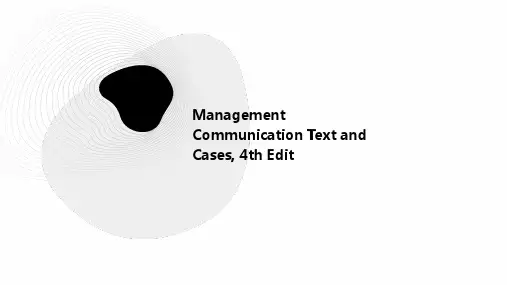
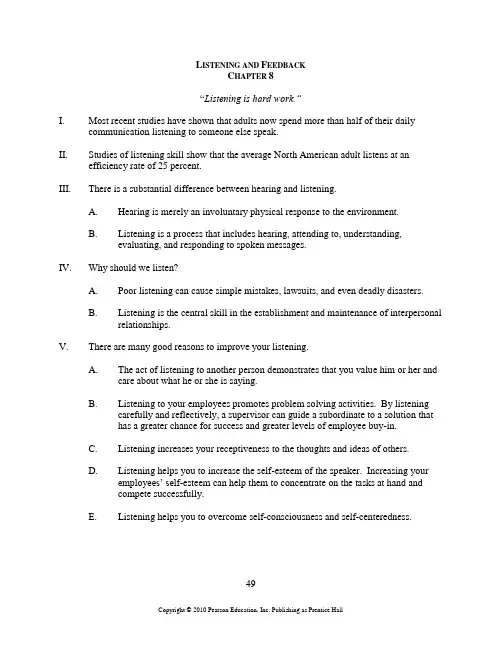
L ISTENING AND F EEDBACKC HAPTER 8“Listening is hard work.”I. Most recent studies have shown that adults now spend more than half of their dailycommunication listening to someone else speak.II. Studies of listening skill show that the average North American adult listens at an efficiency rate of 25 percent.III. There is a substantial difference between hearing and listening.A. Hearing is merely an involuntary physical response to the environment.B. Listening is a process that includes hearing, attending to, understanding,evaluating, and responding to spoken messages.IV. Why should we listen?A. Poor listening can cause simple mistakes, lawsuits, and even deadly disasters.B. Listening is the central skill in the establishment and maintenance of interpersonalrelationships.V. There are many good reasons to improve your listening.A. The act of listening to another person demonstrates that you value him or her andcare about what he or she is saying.B. Listening to your employees promotes problem solving activities. By listeningcarefully and reflectively, a supervisor can guide a subordinate to a solution thathas a greater chance for success and greater levels of employee buy-in.C. Listening increases your receptiveness to the thoughts and ideas of others.D. Listening helps you to increase the self-esteem of the speaker. Increasing youremployees’ self-esteem can help them to concentrate on the tasks at hand andcompete successfully.E. Listening helps you to overcome self-consciousness and self-centeredness.49F. By listening to the concerns and interests of the other person first, you are morelikely to get what you want sooner and with substantially less angst.VI. The first step in becoming a more effective listener is to identify poor listening habits we have developed over a lifetime and replace them with effective, productive habits.A. Here are a few poor listening habits you must recognize and correct to improveyour listening skills:1. Being preoccupied with talking, not listening.2. Calling the subject uninteresting.3. Letting bias or prejudice distort the messages you hear.4. Oversimplifying answers or explanations.5. Yielding to external distractions.6. Yielding to internal distractions.7. Avoiding difficult or demanding material.8. Rationalizing poor listening.9. Criticizing the speaker’s delivery.10. Jumping to conclusions before the speaker has made his/her point.11. Being overly concerned with your response instead of focusing on themessage of the speaker.12. Assigning the wrong meaning to words.13. Listening only for facts and not context, connections, and rhetoricalligatures that link facts to human experience.14. Trying to make an outline of everything you hear or trying to forceinformation into artificial patterns.15. Faking attention to the speaker.16. Letting your heightened emotions regarding word choice or subject matterdistract you from the conversation or speech.5017. Interrupting the speaker to express your own opinion.18. Wasting the differential between the rate at which we speak and the rate atwhich we think.B. Here are a few habits you may want to substitute to effectively improve yourlistening skills:1. Stop talking.2. Participate in only one conversation at a time.3. Empathize with the person speaking.4. Ask questions if you are confused, lost, or need information.5. Although asking questions is useful, don’t interrupt your conversationpartner for a bit.6. Show complete interest in what is being said to you.7. Attain the privacy or proper environment to discuss the matter at hand toensure you will give the speaker your undivided attention.8. Listen critically by evaluating all the facts and evidence.9. Look beyond your assessment of the speaker to the ideas contained in thespeech.10. Realize that just because you want to hear it, that does not mean that thespeaker is saying it.11. Match your expectations of the speaker’s content against what youactually hear and think carefully about what has not been said.12. Tune into the speaker’s mood and intention, as well as the content of thespeech.13. Focus, concentrate, ask questions, and pay attention to what is going on tomake sure you understand the message.VII. To become an effective, empathetic, and skilled listener, you must participate in dialogue.Here are five skills that may help to increase your chances for becoming a successful,active listener.51A. Paraphrase as others speak to show you are actually listening to their words.B. Summarize the feeling of the speaker.C. Reflect the cognitive or logical content of a discussion.D. Review what you have concluded.E. After you have listened, follow through with actions.VIII. Periodically review your communication practices, and your listening habits in particular, to monitor your improvement.A. Here is a four-step process you should use to complete this review:1. Review your listening inventory.2. Recognize your undesirable listening habits.3. Refuse to tolerate undesirable habits.4. Replace undesirable habits with effective ones.IX. You can significantly increase the probability of communication success if you understand the role of feedback in both personal and professional communication.A. Here are some guidelines for constructive feedback:1. Acknowledge the need for feedback to assist in bettering yourorganization.2. Give both positive and negative feedback.3. Understand the context of the feedback (i.e., where it happened, why ithappened, what led up to the event).4. Make sure you are using words whose meaning you both understand.5. Do not speak in a language your conversation partner is likely tomisunderstand, misconstrue, or misinterpret.6. Do not assume anything about the other person - ask for clarification.7. Defuse the hostility, minimize the fear, and depersonalize the conversationby focusing your comments on the behavior involved not the people.528. Know when to give feedback.9. Know how to give feedback.B. Here are a few specific instances when you should not attempt to give feedback:1. You do not know much about the circumstances of the behavior.2. You do not care about the person or will not be around long enough tofollow up the aftermath of you feedback.3. The feedback, positive or negative, is about something the person has nopower to change.4. The other person seems low in self-esteem.5. You are low in self-esteem.6. Your purpose is not really improvement, but to put someone on the spot,or demonstrate how smart or how much more responsible you are.7. The time, place, or circumstances are inappropriate.C. Here are a few suggestions to provide helpful feedback to another person:1. Be descriptive and provide examples.2. Be objective, if possible3. Be clear, specific, and unambiguous.4. Do not exaggerate.5. Do not be judgmental or at least do not use the rhetoric of judgment.6. Take responsibility for your own job - do not refer to absent, anonymouspeople.7. Try to use first-person statements (“I” or “we”) so the effectiveness ofyour comments is not lost in accusation.8. Phrase the issue as a statement, not as a question..9. Focus on issues that are both important to improvement and well withinthe power of the other person to change.5310. Restrict your feedback to things you know for certain.11. Use each opportunity for feedback to establish useful workingrelationships and build long-term trust.12. Help people hear and accept your compliments when giving positivefeedback.D. Here are a few ideas to help refashion criticism so that it conforms to the rules forconstructive feedback:1. Take full, deep breaths to force your body to relax and allow your brain tomaintain greater alertness.2. Listen carefully to the person delivering the criticism.3. Ask questions for clarity.4. Acknowledge the feedback with both verbal and nonverbal indicators.5. Agree to valid points.6. Do not be defensive.7. Try to understand the objectives of the other person.8. Ask the feedback-giver for time to think about what was said and how youfeel about it.54。
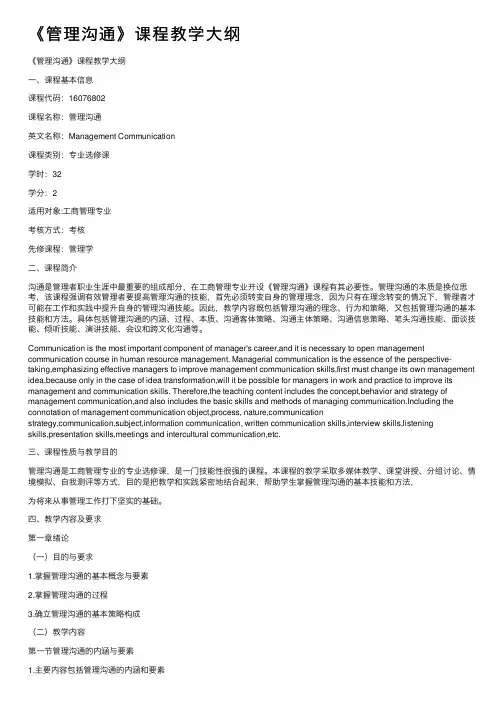
《管理沟通》课程教学⼤纲《管理沟通》课程教学⼤纲⼀、课程基本信息课程代码:16076802课程名称:管理沟通英⽂名称:Management Communication课程类别:专业选修课学时:32学分:2适⽤对象:⼯商管理专业考核⽅式:考核先修课程:管理学⼆、课程简介沟通是管理者职业⽣涯中最重要的组成部分,在⼯商管理专业开设《管理沟通》课程有其必要性。
管理沟通的本质是换位思考,该课程强调有效管理者要提⾼管理沟通的技能,⾸先必须转变⾃⾝的管理理念,因为只有在理念转变的情况下,管理者才可能在⼯作和实践中提升⾃⾝的管理沟通技能。
因此,教学内容既包括管理沟通的理念、⾏为和策略,⼜包括管理沟通的基本技能和⽅法。
具体包括管理沟通的内涵、过程、本质、沟通客体策略、沟通主体策略、沟通信息策略、笔头沟通技能、⾯谈技能、倾听技能、演讲技能、会议和跨⽂化沟通等。
Communication is the most important component of manager's career,and it is necessary to open management communication course in human resource management. Managerial communication is the essence of the perspective-taking,emphasizing effective managers to improve management communication skills,first must change its own management idea,because only in the case of idea transformation,will it be possible for managers in work and practice to improve its management and communication skills. Therefore,the teaching content includes the concept,behavior and strategy of management communication,and also includes the basic skills and methods of managing communication.Including the connotation of management communication object,process, nature,communicationstrategy,communication,subject,information communication, written communication skills,interview skills,listeningskills,presentation skills,meetings and intercultural communication,etc.三、课程性质与教学⽬的管理沟通是⼯商管理专业的专业选修课,是⼀门技能性很强的课程。
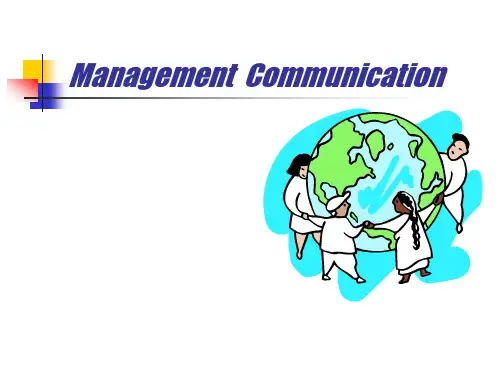
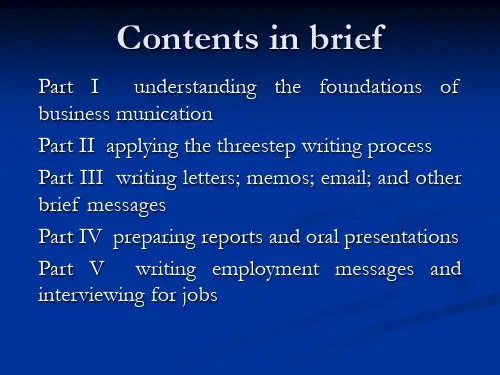
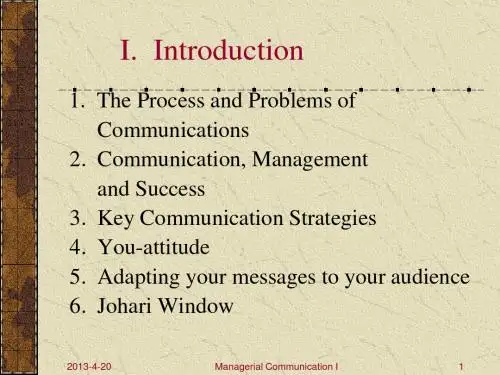
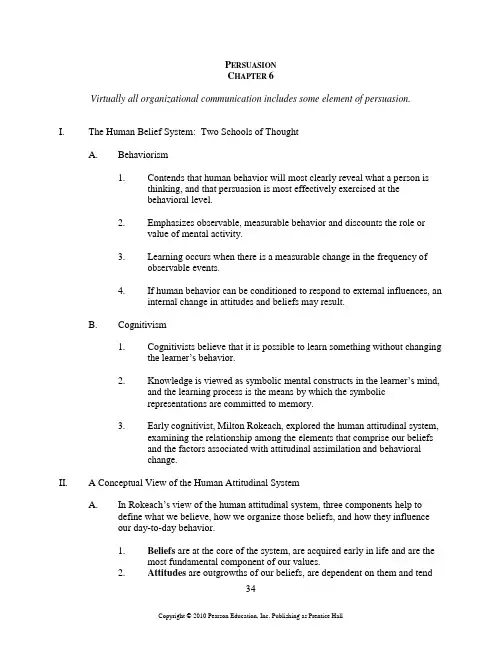
P ERSUASIONC HAPTER 6Virtually all organizational communication includes some element of persuasion.I. The Human Belief System: Two Schools of ThoughtA. Behaviorism1. Contends that human behavior will most clearly reveal what a person isthinking, and that persuasion is most effectively exercised at thebehavioral level.2. Emphasizes observable, measurable behavior and discounts the role orvalue of mental activity.3. Learning occurs when there is a measurable change in the frequency ofobservable events.4. If human behavior can be conditioned to respond to external influences, aninternal change in attitudes and beliefs may result.B. Cognitivism1. Cognitivists believe that it is possible to learn something without changingthe learner’s behavior.2. Knowledge is viewed as symbolic mental constructs in the learner’s mind,and the learning process is the means by which the symbolicrepresentations are committed to memory.3. Early cognitivist, Milton Rokeach, explored the human attitudinal system,examining the relationship among the elements that comprise our beliefsand the factors associated with attitudinal assimilation and behavioralchange.II. A Conceptual View of the Human Attitudinal SystemA. In Rokeach’s view of the human attitudinal system, three components help todefine what we believe, how we organize those beliefs, and how they influenceour day-to-day behavior.1. Beliefs are at the core of the system, are acquired early in life and are themost fundamental component of our values.2. Attitudes are outgrowths of our beliefs, are dependent on them and tendto be consistent with them.3. Opinions are among the least stable and are the most susceptible topersuasion.B. The Role of Beliefs, Attitudes, and Opinions1. Change in one layer may expose a more fundamental layer to re-examination, but will require no change in the more basic layer.2. Change in a basic layer will require change in all higher attitudinal layers.3. The more basic the change, the more profound the reordering throughoutthe system.4. The less rational the basis for adoption, the more difficult is the basis forchange in a given belief or attitude group.5. The closer a str ucture is to the center of one’s belief system, the morecentral it becomes to one’s self-concept.III. Objectives of PersuasionA. Reinforcing positive opinion.B. Crystallizing latent opinion.C. Neutralizing hostile opinion.IV. Outcomes of PersuasionA. Reinforcement of existing attitudes.B. Modification or shifting of existing attitudes.C. Creation of new attitudes.V. The Science of PersuasionA. Liking. We tend to like those who like us, but we also tend to like those who arelike us.B. Reciprocity. People repay in kind, and expect to receive what they give.C. Social proof. People will follow the lead of similar others when they’re asked todo something.D. Consistency. People do what they say they will and appreciate staying withintheir own “comfort zone.”E. Authority. People readily defer to experts.F. Scarcity. The value of an object often rises as fewer become available.VI. Successful Attempts at PersuasionA. Gaining the attention of your audience.B. Providing the appropriate motivation for your audience.1. Human needs as motivationsa. Maslow’s Hierarchy of Human Needs1. Basic needs.2. Security needs.3. Belonging needs.4. Love or esteem needs.5. Self-actualization needs.b. ERG Theory1. Existence needs.2. Relatedness needs.3. Growth needs.c. Packard’s Eight Hidden Needs1. Need for emotional security.2. Need for reassurance of worth.3. Need for ego gratification.4. Need for creative outlets.5. Need for love objects.6. Need for a sense of power.7. Need for roots.8. Need for immortality.2. Relating needs theory to persuasive messagesa. A highly credible source gets a good response from a fear appeal.b. If a strong fear appeal threatens the welfare of a loved one, it tendsto be more effective than if it threatens the members of theaudience themselves.c. A strong fear appeal may be related to personality characteristicsof the audience.d. The arousal of fear in an audience seems to depend on thespeaker’s ability to convince the audience of the probability thatthe threat will materialize and the magnitude of the consequences.3. Social conformity as motivationa. Admired individuals.b. Peer groups.c. Societal norms.C. Channeling the motivation of your audience to take action1. Recommend a specific proposition or proposal.2. Show the high probability that the satisfactions will be forthcoming.D. Inducing resistance in the audience to counter-persuasion1. State opposing arguments and refute them.2. Encourage audience.3. Warn the audience that others will attempt to get them to change theirminds.VII. Should You Use a One-Sided Argument or Two?A. One-sided arguments work best:1. When the audience agrees with your position and your aim is simply tointensify agreement.2. When the audience is not well-educated or has relatively low self-esteem.3. When the audience will not later be exposed to any form of counter-persuasion.B. Two-sided arguments work best:1. When the audience initially disagrees with your proposal.2. When you know the audience will be exposed to subsequent counter-persuasion or propaganda.3. When the audience has a low level of knowledge or personal involvementwith the topic.4. When you hope to produce more enduring results.VIII. Managing Heads and Hearts to Change Behavioral HabitsA. You must create a new frame of reference through which information andmessages are interpreted.B. You must manage the emotions and expectations of your audience.C. You must provide constant reinforcement to prevent backsliding.IX. Five Myths About Changing BehaviorA. Myth #1: Crisis is a powerful impetus for change.B. Myth #2: Change is motivated by fear.C. Myth #3: The facts will set us free.D. Myth #4: Small, gradual changes are always easier to make and sustain.E. Myth #5: We can’t change because our brains become “hard wired” early in life. X. Being PersuasiveA. Know your audience.B. Know what you want and what they want.C. Select your evidence carefully.D. Keep the argument simple.E. Listen before you speak.F. Manage your emotions as well as theirs.G. Connect with your audience on a personal level.。
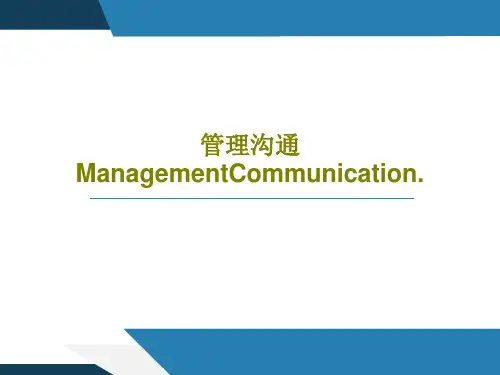
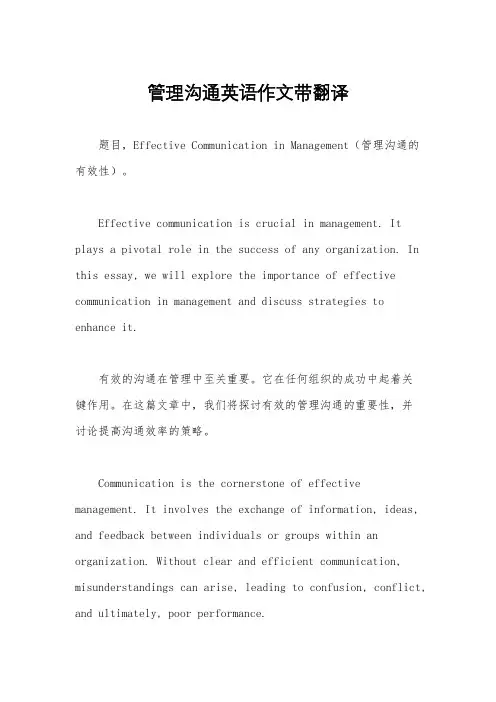
管理沟通英语作文带翻译题目,Effective Communication in Management(管理沟通的有效性)。
Effective communication is crucial in management. It plays a pivotal role in the success of any organization. In this essay, we will explore the importance of effective communication in management and discuss strategies to enhance it.有效的沟通在管理中至关重要。
它在任何组织的成功中起着关键作用。
在这篇文章中,我们将探讨有效的管理沟通的重要性,并讨论提高沟通效率的策略。
Communication is the cornerstone of effective management. It involves the exchange of information, ideas, and feedback between individuals or groups within an organization. Without clear and efficient communication, misunderstandings can arise, leading to confusion, conflict, and ultimately, poor performance.沟通是有效管理的基石。
它涉及组织内个人或群体之间的信息、思想和反馈的交流。
如果没有清晰和高效的沟通,就可能会产生误解,导致混乱、冲突,最终导致业绩不佳。
Effective communication fosters a positive work environment where employees feel valued and understood. It promotes transparency, trust, and collaboration, which are essential for building strong teams and achieving common goals. Managers who communicate effectively are able to motivate their employees, address concerns promptly, and provide constructive feedback for improvement.有效的沟通促进了一个积极的工作环境,员工感到受到重视和理解。
